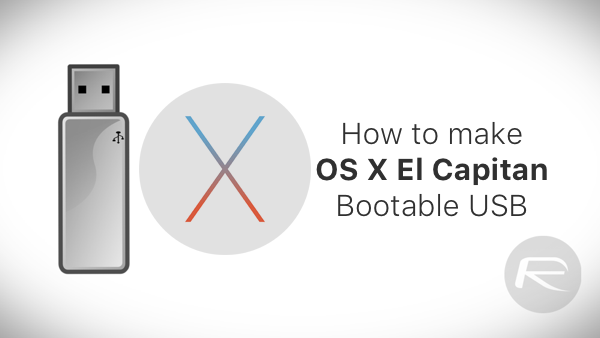- Apple Install El Capitan Free
- Install Macos El Capitan Apple
- Clean Install El Capitan Without Apple Id
- Apple Install El Capitan From Usb
El Capitan Installer. Mac operating system’s twelfth major version is the El Capitan Installer (version 10.11). All the Mac computers which don’t have the privilege to upgrade to MacOS High Sierra or the computers that need to upgrade to El Capitan first, can download this twelfth version on the computer. Open virtual box and click New to create a new virtual machine Then name it El Capitan Type and Version = MAC OS X (64bit) and click on Next. Allocate more than 3GB of ram and click on next. Then click on Use an existing virtual hard disk file and browse for the virtual hard disk file extracted from El Capitan Disk ISO Image and click on Create.
Download Mac OS X El Capitan 10.11.1 DMG free latest standalone offline setup. The Mac OS X El Capitan 10.11.1 DMG is the twelfth major release of OS X providing different enhancements and many new features.
Reviewer: Beau Tibbs - favorite favorite favorite favorite - February 6, 2021 Subject: El Capitan installer - be patient I used this installer to put back an apple OS on my mid 2009 MacBook Pro. The progress indicator was nicely counting down until it said 'about one second remaining'. Macbook Pro 13' 2015 with OS X Yosemite on board. I've been trying to install OS X El Capitan, but always get the following message: 'This copy of the Install OS X El Capitan application can't be verified. It may have been corrupted or tampered with during downloading.' By the way this is not a date time issue, date is correct on my computer. Compared to versions of Mac OS X released after El Capitan, such as Sierra, El Capitan generally is not faster. Mac computers dating from 2012 and later will generally run more smoothly when upgraded from El Capitan, per Apple's optimizations in Sierra and later. On the other hand, Macs from 2008 to 2010 may run faster with El Capitan.
Mac OS X El Capitan 10.11.1 DMG Review
Among different Mac OS X releases, El Capitan 10.11 is known as a prominent release now known as macOS El Capitan providing numerous enhancements and a wide range of powerful features. It provides a sleeker user interface with an eye-catching environment; the users can find everything with the glimpse of an eye. This release basically focusses on the compatibility, security and the stability. There is a bundle of fixes that improve the performance and the reliability of the OS.
El Capitan Apple Os Download
Numerous updates and enhancements make it even more stable environment than other previous OS X releases. Various new updated components and enhancements for mailboxes in Mail, various issue fixes and a bundle of compatibility enhancements are there for the ease of the users. It provides better compatibility for Microsoft Office 2016 as well as over 150 new emoji characters are added. All in all, it is a stable Mac OS X release providing a bundle of enhancements and issue fixes.
Features of Mac OS X El Capitan 10.11.1
- Focusses on stability, reliability, compatibility, and security of MAC
- Various updating components, issue fixes, and feature enhancements
- Addresses an issue with the mailboxes in Mail
- Provides better compatibility with Microsoft Office 2016
- Enhancements for different audio plugins and VoiceOver reliability
- Various enhancements for Maps, Safari, and Notes etc.
- Over 150 emoji characters are added
Technical Details of Mac OS X El Capitan 10.11.1 DMG
- File Name: Install_OS_X_El_Capitan.app.dmg
- File Size: 5.6 GB
- Developer: Apple
Apple Install El Capitan Free
System Requirements for Mac OS X El Capitan 10.11.1 DMG
- 10 GB free HDD
- 4 GB RAM
- Intel Multi-Core Processor
macOS El Capitan 10.11.1 DMG Free Download

Download macOS El Capitan 10.11.1 latest version free DMG image installer for Macintosh by clicking the below button. You can also download Mac OS X El Capitan 10.11.6
These advanced steps are primarily for system administrators and others who are familiar with the command line. You don't need a bootable installer to upgrade macOS or reinstall macOS, but it can be useful when you want to install on multiple computers without downloading the installer each time.
What you need to create a bootable installer
- A USB flash drive or other secondary volume formatted as Mac OS Extended, with at least 14GB of available storage
- A downloaded installer for macOS Big Sur, Catalina, Mojave, High Sierra, or El Capitan
Download macOS
- Download: macOS Big Sur, macOS Catalina, macOS Mojave, or macOS High Sierra
These download to your Applications folder as an app named Install macOS [version name]. If the installer opens after downloading, quit it without continuing installation. To get the correct installer, download from a Mac that is using macOS Sierra 10.12.5 or later, or El Capitan 10.11.6. Enterprise administrators, please download from Apple, not a locally hosted software-update server. - Download: OS X El Capitan
This downloads as a disk image named InstallMacOSX.dmg. On a Mac that is compatible with El Capitan, open the disk image and run the installer within, named InstallMacOSX.pkg. It installs an app named Install OS X El Capitan into your Applications folder. You will create the bootable installer from this app, not from the disk image or .pkg installer.
El Capitan Apple Software
Use the 'createinstallmedia' command in Terminal
- Connect the USB flash drive or other volume that you're using for the bootable installer.
- Open Terminal, which is in the Utilities folder of your Applications folder.
- Type or paste one of the following commands in Terminal. These assume that the installer is in your Applications folder, and MyVolume is the name of the USB flash drive or other volume you're using. If it has a different name, replace
MyVolumein these commands with the name of your volume.
Big Sur:*
Catalina:*
Mac os high sierra boot camp windows 10. MacOS High Sierra 10.13.4 and later don't support eGPUs in Windows using Boot Camp or when your Mac is in macOS Recovery or installing system updates. These chassis provide at least 85 watts of charging power, making them ideal for use with 15-inch MacBook Pro models. MacOS High Sierra 10.13 and macOS High Sierra 10.13.1. IPhone 5s and later, iPad Air and later, and iPod touch 6th generation. IPhone 5s and later, iPad Air and later, and iPod touch 6th generation. ICloud for Windows 7.1. Windows 7 and later. ITunes 12.7.1 for Windows. Before you upgrade, we recommend that you back up your Mac. If your Mac is running OS X Mavericks 10.9 or later, you can upgrade directly to macOS Big Sur. You’ll need the following: OS X 10.9 or later; 4GB of memory; 35.5GB available storage on macOS Sierra or later. Some features require an Apple ID; terms apply.
Install Macos El Capitan Apple
Mojave:*
High Sierra:*
El Capitan:
* If your Mac is using macOS Sierra or earlier, include the --applicationpath argument and installer path, similar to the way this is done in the command for El Capitan.
Clean Install El Capitan Without Apple Id

After typing the command:
- Press Return to enter the command.
- When prompted, type your administrator password and press Return again. Terminal doesn't show any characters as you type your password.
- When prompted, type
Yto confirm that you want to erase the volume, then press Return. Terminal shows the progress as the volume is erased. - After the volume is erased, you may see an alert that Terminal would like to access files on a removable volume. Click OK to allow the copy to proceed.
- When Terminal says that it's done, the volume will have the same name as the installer you downloaded, such as Install macOS Big Sur. You can now quit Terminal and eject the volume.
Use the bootable installer
Determine whether you're using a Mac with Apple silicon, then follow the appropriate steps:
Apple silicon
- Plug the bootable installer into a Mac that is connected to the internet and compatible with the version of macOS you're installing.
- Turn on your Mac and continue to hold the power button until you see the startup options window, which shows your bootable volumes and a gear icon labled Options.
- Select the volume containing the bootable installer, then click Continue.
- When the macOS installer opens, follow the onscreen instructions.
El Capitan Apple Store Link
Intel processor

- Plug the bootable installer into a Mac that is connected to the internet and compatible with the version of macOS you're installing.
- Press and hold the Option (Alt) ⌥ key immediately after turning on or restarting your Mac.
- Release the Option key when you see a dark screen showing your bootable volumes.
- Select the volume containing the bootable installer. Then click the up arrow or press Return.
If you can't start up from the bootable installer, make sure that the External Boot setting in Startup Security Utility is set to allow booting from external media. - Choose your language, if prompted.
- Select Install macOS (or Install OS X) from the Utilities window, then click Continue and follow the onscreen instructions.
Learn more
For more information about the createinstallmedia command and the arguments that you can use with it, make sure that the macOS installer is in your Applications folder, then enter the appropriate path in Terminal:
El Capitan Apple Software
- Big Sur: /Applications/Install macOS Big Sur.app/Contents/Resources/createinstallmedia
- Catalina: /Applications/Install macOS Catalina.app/Contents/Resources/createinstallmedia
- Mojave: /Applications/Install macOS Mojave.app/Contents/Resources/createinstallmedia
- High Sierra: /Applications/Install macOS High Sierra.app/Contents/Resources/createinstallmedia
- El Capitan: /Applications/Install OS X El Capitan.app/Contents/Resources/createinstallmedia
El Capitan Apple Wallpaper

A bootable installer doesn't download macOS from the internet, but it does require an internet connection to get firmware and other information specific to the Mac model.
macOS Big Sur elevates the most advanced desktop operating system in the world to a new level of power and beauty. Experience Mac to the fullest with a refined new design. Enjoy the biggest Safari update ever. Discover new features for Maps and Messages. And get even more transparency around your privacy.
Check compatibility
macOS Big Sur is compatible with the following computers. If your Mac isn't compatible, you might be able to install an old version of macOS instead.
MacBook introduced in 2015 or later
MacBook Air introduced in 2013 or later
MacBook Pro introduced in late 2013 or later
Mac mini introduced in 2014 or later
iMac introduced in 2014 or later
iMac Pro
Mac Pro introduced in 2013 or later
View the complete list of compatible computers.
If upgrading from macOS Sierra or later, your Mac needs 35.5GB of available storage to upgrade. If upgrading from an earlier release, your Mac needs up to 44.5GB of available storage. To upgrade from OS X Mountain Lion, first upgrade to OS X El Capitan, then upgrade to macOS Big Sur.
Download macOS Big Sur
If you're using macOS Mojave or later, get macOS Big Sur via Software Update: Choose Apple menu > System Preferences, then click Software Update.
Or use this link to open the macOS Big Sur page on the App Store: Get macOS Big Sur. Then click the Get button or iCloud download icon.
Install macOS Big Sur

After downloading, the installer opens automatically. Click Continue and follow the onscreen instructions.
Please allow installation to complete without putting your Mac to sleep or closing its lid. During installation, it might restart and show a progress bar or blank screen several times. You might find it easiest to begin installation in the evening so that it can complete overnight, if needed.
Stay up to date
Apple Install El Capitan From Usb
After installing macOS Big Sur, you will be notified when updates to macOS Big Sur are available. To check for updates, choose Apple menu > System Preferences, then click Software Update.